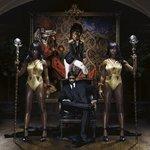
Santigold Master of My Make-Believe
(Atlantic)
Waiting four years between the release of a debut and sophomore album has become a bad omen for countless artists. Many reside in the comfort of their debut’s success for too long, making any attempt at redefining their career unimaginable. For Santigold, moniker of Santi White, the delay between her 2008 self-titled debut and this year’s Master of My Make-Believe has been attributed to label issues, songwriting issues, touring, and so on. The hype surrounding this follow-up has been immense, and for good reason: the genre-defying palette of her debut – pop, new wave, reggae, hip-hop, punk – has won White a massive worldwide audience. White’s fans are familiar with her disposition of artist authenticity, and her debut was a testament to her fresh take on the underground of pop music. On Make-Believe, a sloppy more-of-the-same same approach has crippled what this album could have been, ultimately leaving us with some vaguely interesting notions rather than well-explored concepts.
With a cast like Diplo, Switch, Dave Sitek of TV on the Radio, Nick Zinner of the Yeah Yeah Yeahs, Q-Tip, Boys Noize and more on production, any fan’s expectations should be high. However, what follows seems to be an identity crisis of an album. There are times when Santigold evokes the bombastic energy of her debut (Go!, Big Mouth) and times when she seems to making more of an emphasis on mid-tempo songwriting (The Riot’s Gone, God From the Machine). Mixing the two without transition has left a pretty poor consistency to the album, which may seem paradoxical for an artist who explored so many different avenues on her debut. What made Santigold (or the pre-lawsuit Santogold) so effective was that White invested as much energy and power into each style, whether it was the pop of L.E.S. Artistes or the electro ambush of Creator. On Make-Believe, she is not the “introvert and excavator” she declared herself to be, but instead a tired remnant of that songwriter.
Consequently, White’s repetitive exclamations of authenticity are no longer convincing, but instead sound cocky. Instead of speaking against the Lower East Side poseur culture from the outskirts of pop music, songs like Go! and Big Mouth just seem like an arbitrary pissing contest. And really, who is going to hear Freak Like Me and believe White is not trying to build an unnecessary bridge between M.I.A. and Gwen Stefani? Thankfully, there are moments when Make-Believe delivers. Disparate Youth sheds light on a sobered perspective of ambition: “We know that we want more/A life worth fighting for.” The music shows the influence of TV on the Radio, with a mellow, electro ambience over a sedated D&B beat. Elsewhere, Fame induces one massive fist-pumping session in the heavy bass of the chorus (and not in the Jersey Shore fashion, I assure you).
The Keepers isn’t exactly the greatest composition of White’s career, but it’s enough to break the spell of the preceding mush of over-calculated yet underwhelming songs. Between This Isn’t Our Parade and Pirate in the Water, it is clear that Santigold’s talents as a songwriter have been exhausted. Perhaps this is from excessive touring, or perhaps her renowned status as an underground musician has been undermined by her success in the past four years. The only song remaining that deserves recognition is Look at These Hoes, which sounds ridiculous upon first listen, but becomes one of the album’s strongest and most sincere moments. Mocking her stage name, White chants “Tear it up, I’m so damn gold.” It’s in this song that perhaps we find what would have made this album successful: self-parody. For White to have the humility to accept that the Santigold name has become an institution and play off of her unwilling success could have been brilliant. Instead, Master of My Make-Believe seems to showcase an artist who is simply tired too soon.
4 June, 2012 - 21:05 — David Hogg